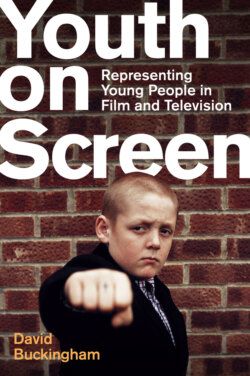Читать книгу Youth on Screen - David Buckingham - Страница 12
Constructing delinquency
ОглавлениеThe wave of concern that was both reflected and constructed in the JD films of the 1950s was by no means new. The history of anxiety about youthful misbehaviour dates back many centuries.2 The idea that the younger generation is out of control is often taken as evidence for much broader claims about cultural or moral decline. As I noted in chapter 1, the early twentieth century psychologists who defined – and effectively invented – ‘adolescence’ as a unique life-stage clearly saw it as a period of fragility, vulnerability and risk. With the advent of modernity, young people increasingly came to be seen as both troubled and troubling.3
Yet what remains striking – and in need of explanation – is that these waves of concern often seem to bear little relationship to the actual incidence of youth crime. The ‘facts’ on youth crime are very difficult to establish because the evidence is so unreliable. Official crime statistics – as well as other data such as victim surveys and self-report studies – vary significantly depending upon which kinds of behaviour are perceived as crimes and which measures are used (for example, whether crimes are reported, or recorded, or result in arrests and convictions), as well as how these figures are interpreted.4
For contemporary criminologists, the issue here is more to do with labelling – that is, how it is that some kinds of behaviour come to be defined as ‘delinquent’ in the first place. In the case of youth, there is a particular issue of status offences: that is, types of behaviour that are defined as criminal when committed by young people, yet are not seen in this way when adults commit them. There is a history of such youth-related crimes – often of a very minor kind – being ‘legislated into existence’ in this way; and alternative sentencing and punishment regimes for juveniles – such as reform schools – are then designed to treat the problem. In other words, public debate, and then the legal system, effectively criminalizes particular kinds of youth behaviour.
The label ‘juvenile delinquent’ really entered into public debate only in the post-war period, when it came to be defined as a specific, and somewhat new, social problem. Nevertheless, public anxiety about the problem of delinquency was oddly out of step with the apparent incidence of youth crime. There were waves of concern immediately after the Second World War and then again in the mid-1950s (1953–8). Public debate on the issue began to fade away in the late 1950s, although statistics (however unreliable) do not suggest that youth crime had fallen at this time: in effect, what had disappeared, or at least declined, was the particular way of formulating the ‘problem’ – in other words, the label of ‘juvenile delinquency’.5
Nevertheless, there were some underlying social changes in the period, for which ‘juvenile delinquency’ became a kind of shorthand. Changes in family life during the war – men fighting and women working – led to concerns about a breakdown in family communication and socialization. As in the conclusion of Altman’s Delinquents, many commentators emphasized traditional notions of family and community as a means of preventing impending social collapse. Meanwhile, the 1950s was a period of increasing affluence and greater youth autonomy: the social and generational changes that eventually erupted in the 1960s were already beginning to appear. In this context, ‘delinquency’ became a coded term for much broader shifts in young people’s behaviour. Part of the concern here was provoked by the gradual integration of distinct racial groups (the black rhythm and blues group in the preface to Altman’s film is not coincidental) and by fears about middle-class white Americans being somehow corrupted by their increasing access to ‘lower-class’ fashions and styles of behaviour, not least through the institution of the high school. Such changes, it was feared, would turn young people into premature adults.
The uneven response to juvenile delinquency may simply have reflected the fact that public opinion was slow to catch up with these changes.6 However, there were also numerous intermediaries and commentators who took it upon themselves to define and explain the phenomenon: journalists, campaigners and lobby groups, ambitious politicians, philanthropic foundations, academics, social workers and law-enforcement agencies all had different motivations for talking up the problem of juvenile delinquency. Numerous explanations of the apparent epidemic of delinquency were proffered at the time; and these different ways of framing the problem also inevitably implied particular solutions to it. Where sociologists tended to emphasize the breakdown of mechanisms of social control (especially among immigrant groups) or the role of social class and poverty, psychologists were more inclined to consider the precarious nature of the modern family or the difficulties of social adjustment during adolescence. However, as the debate evolved, much of the concern came to focus specifically on the influence of the media and mass culture.
